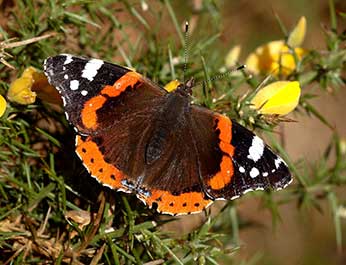Red Admiral (Vanessa atalanta)
When: Primarily March to October
How many: Good numbers are often present

on a gorse bush
Although in some years abundant and widespread, Red Admirals occur annually in variable numbers. They are primarily migratory creatures that originate in North Africa and continental Europe, but small numbers sometimes successfully over-winter in Britain, particularly in the south of England.
Red Admirals are large insects - wingspan is around 7 centimetres - with bold, mainly black, red and white patterning that probably needs little description. The underside of the hindwing, however, is altogether duller, and provides effective camouflage when the butterflies are at rest with wings closed. Both sexes are of similar appearance.
Red Admiral sightings are often reported in virtually every month of the year, although they are most frequently seen from spring until October and occasionally during mild spells in November. Following spring and early summer matings, newly emerged insects are on the wing from around July onwards.
They are frequent garden visitors that also occur widely in the countryside, including in much of the New Forest - wildflower-rich woodland rides, woodland edges and clearings are often favoured, and so is heathland when the heathers are in bloom.
Nectar is taken from a large variety of flowers, whilst the juices of rotting fruit and tree sap will also be enthusiastically devoured. Feeding is said to become a late summer preoccupation, presumably in readiness for return migration, which can sometimes be observed from the Hampshire coast, or to build up reserves in preparation for over-wintering attempts.
References:
Butterflies of the British Isles: J.A. Thomas
The Butterflies of Hampshire: Matthew Oates, John Taverner, David Green et al
The Millennium Atlas of Butterflies in Britain and Ireland: Jim Asher, Martin Warren, Richard Fox, Paul Harding, Gail Jeffcoate and Stephen Jeffcoate
Insects of the New Forest - Paul Brock
More links
Other related links
Search this site

Sadly, 58 animals were killed - 35 ponies, 13 cows, 8 donkeys and 2 sheep, whilst a further 32 were injured - 3 pigs, 9 donkeys, 11 cows and 9 ponies.
(Forty-three accidents occurred in daylight, 15 at twilight and 101 in the dark. Twenty-seven accidents were not reported by the driver involved).
Here's just one horrific example - Three donkeys killed in collision with van at notorious New Forest blackspot (Advertiser and Times)

